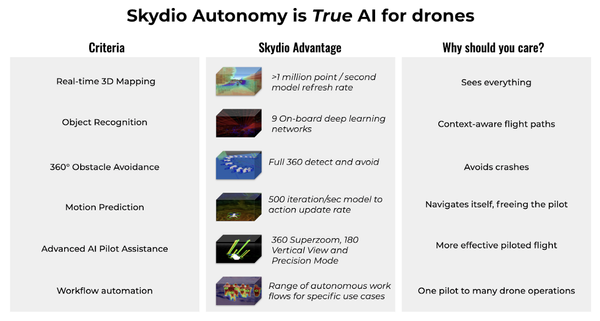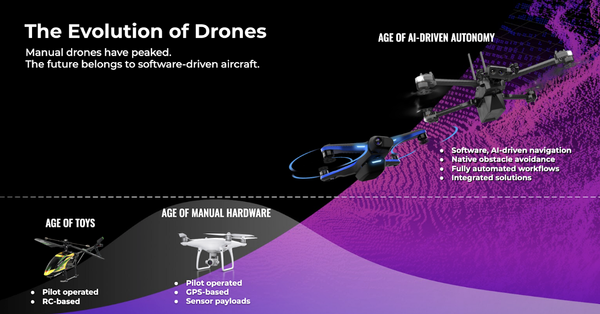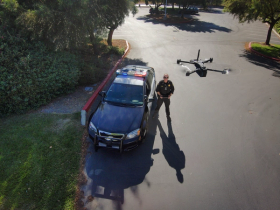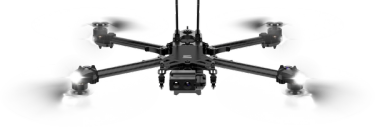Advanced drone autonomy is at the core of Skydio. To demonstrate how we go above and beyond other manufacturers, I’d like to share some ideas about autonomy — what true autonomy is, why it matters, and how it will impact drone operations across the industry.
Before Covid, I had the joy of traveling the country and globe, showing the promise of Skydio to first responders, utilities, state agencies, inspectors of all kinds of assets, and of course, just plain drone people. In these demos, the most common reaction was for people to drop their jaws over the way Skydio drones fly, then use words that I can’t write here to tell me exactly what they think. Once, a police chief ran back into the station during a parking lot demo, to emerge moments later with everyone in the building in tow. Skydio 2 is a sleek piece of hardware, but the magic is the software that drives the hardware: Skydio Autonomy™. It took over six years from every single person at Skydio for our autonomy technology to reach its current level.
Autonomy is the key to turning drones into useful, scalable, trusted tools that businesses can use and rely on every day. Let's go over the key capabilities in our autonomy system, the value those capabilities will provide, and how to build your drone program to join the autonomous revolution.
What Is True Drone Autonomy?
Skydio is far from the first drone company to lay claim to some form of autonomy. There are drones that dabble in tracking, waypoint missions, and grid flights for mapping. It can be difficult to discern which drones are just using GPS waypoints, and which have the deep autonomy required to enable revolutionary new use cases.
Skydio’s approach to autonomy is fundamentally different from the rest of the industry’s, and the ramifications of that approach have make-or-break impacts on what our pilots are able to achieve.
Our aircraft carry the Nvidia TX2 — the fastest, most power-efficient embedded AI computing device available — and six fisheye, 4K navigation cameras that see everything around the drone, just a few of the hardware choices made with autonomy in mind. However, the secret sauce is the software. The hardware is designed from the ground up to support a full-fledged autonomy stack that helps you get the most out of every flight. At a very high level, you can think of Autonomy being composed of the following core tenets:

We build our drones around these capabilities because they impact your operations as a Skydio pilot. Here are some ways you may have been missing these capabilities without even realizing it:
Real-Time 3D Mapping
Have you ever had your drone dodge one obstacle only to run headlong into another?
A first responder friend of mine once shared a story about his DJI Mavic dodging a long branch only to lodge itself in the rest of the tree. That’s because the Mavic, though it can detect an obstacle here and there, is purely reactive. It never has a real understanding of its surroundings at any given moment.
Skydio Autonomy continuously builds a real-time 3D map of its surroundings at all times. The difference is particularly clear when you compare the tracking skills on DJI vs. Skydio drones. The review below refers to the difference as “not even fair.” His Mavic does not even survive through the second minute of the review before crashing into a tree. Two minutes later, the drone is in a tree again. The reviewer concludes: “I just don’t feel comfortable flying this drone on Active Track…let’s go get the Skydio 2.”
Object Recognition
Have you ever wished your drone could have dodged that pesky obstacle you couldn’t see?
Skydio drones can dodge obstacles that even their cameras can’t detect. Our context-aware AI algorithms can draw conclusions about what they see — for example, concluding that a cable the cameras show floating in mid-air is likely to extend in both directions. That lets them dodge obstacles that their human pilots miss, and is critical to avoiding entire categories of drone crashes.
360° Obstacle Avoidance
Have you ever lost connection to your drone and been terrified it would crash during its automated return to home?
Many manual drones, like the Mavic series, claim “omnidirectional obstacle avoidance” but lack full 360° sensor coverage, so without their pilots, they are prone to crash into obstacles in their blind spots.
The six navigation cameras on Skydio drones have no blind spots, enabling our drones to deftly bob and weave around obstacles when flying autonomously. The Civil Air Patrol switched to Skydio 2 as their base drone, after realizing that obstacle avoidance lets them safely perform missions that would have otherwise been limited to extremely skilled pilots staying safe from obstacles at high altitude. They are able to reimagine their urban search and rescue protocols in ways that will be invaluable for disaster relief.
Motion Prediction
Have you ever gotten “stuck,” unable to fly where you want to because your collision avoidance sensors are stopping your drone in its tracks?
It’s such a common problem that DJI drones even allow you to disable obstacle avoidance through Sport Mode. That’s because they don’t have motion prediction, which allows Skydio drones to plot intelligent paths around obstacles. The result is the feeling that you, the pilot, are just telling your drone where to go, while it handles the necessary twists and turns.
Advanced AI Pilot Assistance
Have you ever had trouble seeing what you wanted to see with your drone because you had to focus on flying safely?
Manual drones like the DJI Phantom attempt to solve this problem by throwing people at it through two-person operations — a hardly scalable approach. Our approach is to supplement the pilot with artificial intelligence, instead of another employee. I watched a bridge inspection pilot explain this to her boss once.
He was skeptical that his team was using autonomy because there was still a pilot in command with a controller, but she reminded him that Skydio AI is not just letting the pilot know obstacles are present, it is actively — autonomously — intervening to navigate past them. With the confidence of an AI engine having her back, she is able to fly closer to the assets she is inspecting, capturing angles no other drone allows her to, with greater resolution than much more expensive cameras are able to generate from farther stand-off distances.
Workflow Automation
Have you ever had to go back after a mapping flight and capture more data with a really difficult manual flight?
A pilot I spoke with at a conference once told me of a time he got his Phantom stuck in the Golden Arches of a McDonald’s while trying to map the parking lot. The drone, apparently, is still up there. Mishaps are really common during autonomous mapping missions, and as a result, pilots are afraid to supplement their grid pattern flights with dangerous manual flights.
We design our autonomous workflows such that the drone can assess its surroundings and make its own decisions, capturing better data safer than a human pilot ever could. The operator is now a manager, not a pilot, which is much more scalable and safer as a drone program grows. Skydio drones can even add intelligence to the scripts and make their own decisions in mid-air through Skydio 3D Scan™ and Skydio House Scan™.
This is why any truly autonomous drone requires both hardware and software to work together to provide all six of the core tenets we describe in the table above. Sure, other drones can follow a script — DJI ActiveTrack, or a photogrammetry lawnmower pattern flight. But if your hardware and software aren’t tightly coupled and built from the ground up for autonomy, these applications will always be limited, and dangerous.
What Will Autonomy And Drone Intelligence Do For Your Program?
While GPS and magnetometers enabled the current generation of manual drones to evolve from toys and start to add enterprise value in the hands of skilled operators, the next era of the drone industry belongs to software-driven technology powered by breakthrough artificial intelligence that can make drones work for their pilots, instead of the other way around. This approach to autonomy translates into paradigm-shifting products that will help you take your drone program to the next level.

At the end of the day, autonomy saves our customers money, and it makes a difference for everyone in the program.
Drone Users
From Skydio Autonomy reducing the risk of crashes even in up-close flights, to 3D Scan automating entire missions while capturing higher-precision data, our autonomy products make life easier both for drone pilots and those who use drone data to make decisions.
Risk teams
Although drone crashes generally have smaller consequences than failures of the methods they replace (i.e., helicopters, tower climbs, snooper trucks), they are still a liability — in a recent poll, 55% of respondents from over 100 enterprises cited “Risk of Crashes” as the #1 concern with manual drones. And for good reason — crashes can even ground entire fleets. Autonomy helps mitigate risk and get a program over the legal hurdles that can delay implementation.
Program Managers
In a drone program, hiring, training, and retaining qualified pilots consumes up to 80% of the overall budget. Autonomy can reduce total cost of ownership by up to 40% by reducing the training burden, and allowing fewer pilots to complete more missions in less time.

With all these benefits, it’s no wonder that marketing teams across the drone industry try to lay claim to autonomy and drone intelligence. It can be really difficult, as a buyer, to tell the difference between marketing jargon and true autonomy. Other companies can easily edit video to make it look like their drones fly like Skydios, but in a live demo, any seasoned DJI or Parrot pilot instantly recognizes the vast chasm between those drones’ capabilities and Skydios’. That is why we highly encourage you to get your hands on a Skydio 2 and experience it first hand.
If you are interested in putting Skydio Autonomy to work on your team’s problems, please do get in touch via our Contact Us form.



